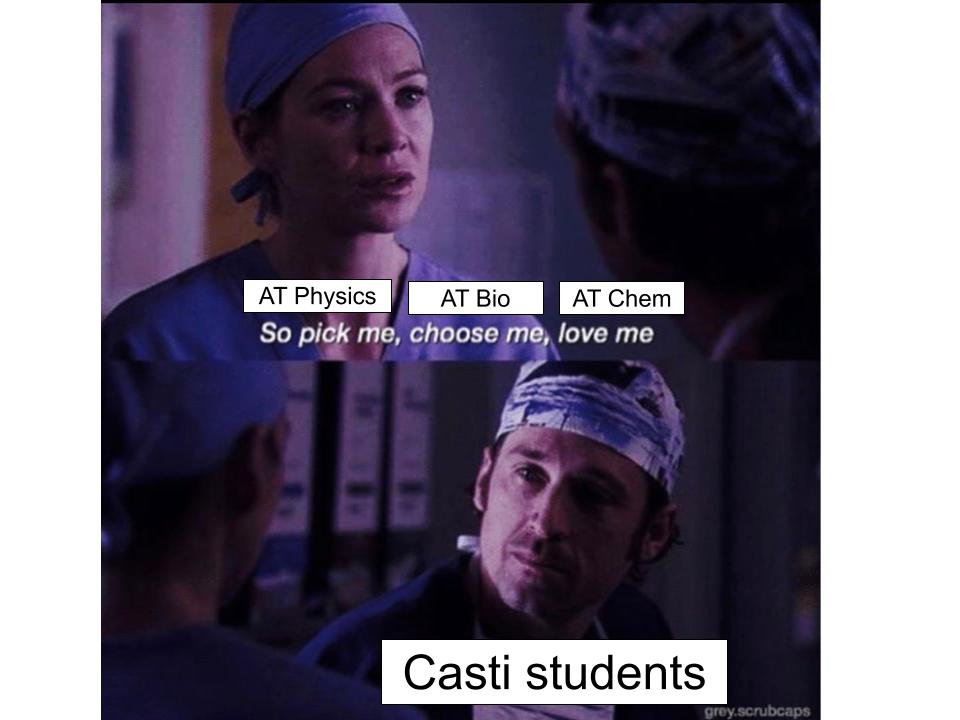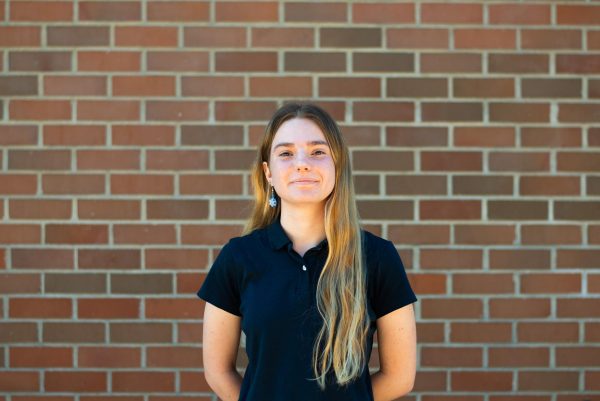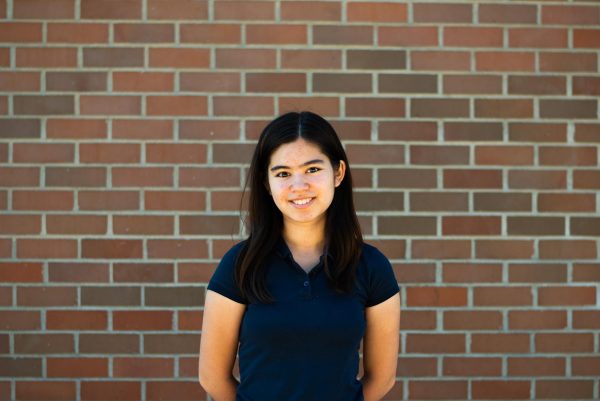At Castilleja, students interested in the sciences have the option of taking Advanced Topics in Physics, Advanced Topics in Biology and Advanced Topics in Chemistry. Each class has its own characteristics, but what they all have in common is that they are not bound to the Advanced Placement test for their respective course.
AT Biology teacher Zoe Clute remarked that she can take her class in lots of different directions and likes to tailor it to match students’ interests. AT Physics teacher Jon Rockman also appreciates the freedom the AT structure offers and that he doesn’t have to prepare students for the AP exam.
So with each class having its own unique curriculum and projects, which science class(es) should a student consider taking and why? Let’s explore.
AT Physics
You should take physics “because it’s awesome,” Rockman said. More specifically, two main reasons are if a student is “interested in the topic and want[s] to learn more” or if they’re “thinking of a possible college major in physics or engineering” and want exposure to a collegiate physics course.
For example, senior Lexie Stinson ’24 is taking physics because she plans to pursue engineering in college and because she had “a lot of fun” in the intro physics class in freshman year.
“I like the fact that it’s an elective, so students are choosing to be there,” Rockman said, which means there’s “feedback between [the teacher’s] interest and the students’ interest.”
While the other AT science classes are taken after less time since their respective introductory courses, physics is the freshman introductory science course, which typically means the most elapsed time before AT Physics.
“That makes it challenging because it’s this mixture of an Advanced Topics class but also kind of a second intro class,” Rockman said.
“It’s a little bit more homework than usual,” Stinson said. “Otherwise, it’s been pretty chill…[and not] too bad compared to other AT [science] courses.” She also appreciates its “applications to real life.”
AT Physics includes three rounds of “current event” presentations, where students present on any physics topic of their choosing, even not current ones. Stinson loves to see her classmates’ interests combined with the physics that was being studied. As for her topics: “One presentation was on dark energy, one was on dark matter, and one was on different types of eclipses because we had just seen a total solar eclipse.”
Rockman’s favorite activity in the course is a lab involving LEDs where the classes “measur[ed] the turn-on voltage and the peak color and us[ed] that to calculate Plank’s constant. I just think that’s super cool, and I love that,” Rockman said.
Stinson’s favorite was the unit about light, which she found interesting because it “related to so many concepts that we see in the real world.”
AT Biology
Clute believes that students should choose to take AT Bio because it’s “an awesome opportunity” to explore topics that are, as she believes, “by default really interesting to all humans because you learn about how your body works, how animals work and how systems work in the living things around you.” To her, this feels “relevant to being a human existing in the world.”
Furthermore, “It’s an opportunity to develop independence and agency that you might need to study in college going forward,” Clute said. Even if science is not a passion, she says, “it’s a great opportunity to practice project-based group work and independent work that is going to guide you to be successful in collegiate courses, literature review, paper writing and working even past that in making things like pitches or operating in the workplace.”
Clute’s favorite aspect of teaching this course is the freedom to build on what was learned in junior year during the required introductory-level biology course. She’s grateful for “the ability to introduce all kinds of cool things that follow student interests and that work in advanced spheres of biology of all different kinds…and build into these crazy, new places.”
Greta Bollyky ’24 is considering medicine as a future career and is interested in biology, so she chose to take AT Bio to prepare herself for college courses. She says the course is challenging and time-consuming “because there is a lot to memorize and a lot to work on…but it definitely has been worthwhile and would recommend taking it to anyone…Ms. Clute is a really good teacher.”
According to Clute, one of the more challenging parts of the course is the Independent Research Proposal, or IRP, which extends through almost the whole year.
“In this project, there’s a lot of agency,” Clute said, with this agency including choosing a topic and completing the research proposal. Independence in such a deep, large-scale project can be stressful and difficult, “but it’s exciting to watch people come out the other side of that and feel powerful in their agency about choosing topics.”
Clute described one of her two favorite topics to teach in the class as “a combination of cell-signaling and reproductive and developmental biology,” which is of personal interest to her with her background in child and adolescent biology. “People tend to not spend that much time thinking about how biological things like pregnancy work, and it’s just wild that they work at all or that that’s possible,” she said.
She enjoys talking about these biological processes from molecular and cultural perspectives and exploring evidence such as “historical readings about doctors’ first interpretations of menstruation and pregnancy, how that has shifted over time and how biases are still included in the medical system.” She appreciates the interdisciplinary nature of the unit as it brings together molecular and sociological perspectives.
Her other favorite unit, which is similarly interdisciplinary, is that which studies “human body systems of other kinds,” bringing together “neuroscience, psychology, mental health, drugs and neurotransmitters.”
On the other hand, Bollyky’s favorite part of the course was a project that entailed “educational comic book pages about a certain macromolecule.” Bollyky chose to focus her project on phospholipids, and she found it fun “because it combined a bit of artistic and creative aspects with the actual scientific components of biology.”
AT Chemistry
If “you really like chemistry, you are curious about the physical world around you and you want to understand it better,” AT Chemistry teacher Bethany Blackwell said, then you should take AT Chemistry. Because chemistry is sometimes referred to as “the central science,” she said, students can make connections to many other subjects such as mathematics, physics and biology.
Naya Sangoram ’25 is taking AT Chemistry because she was interested in the subject and knew she wanted to take the class during her time at Castilleja. She chose to take the course in her junior year so that she would better remember what she’d learned in sophomore year chemistry.
Blackwell agrees, saying if there was more a student wanted to learn in sophomore year, but didn’t get the chance to “because they were beyond the scope of the class, that’s why [they] should take AT Chemistry: so [they] can learn more of the cool, interesting stuff.”
Additionally, if you are planning to pursue studies in STEM and will eventually have to take an advanced chemistry class, then taking this course at Castilleja, where the class size will be smaller, means that you can receive more support, Blackwell explained. Even if you have to take the class again in college, you will still be familiar with the content and have an easier time.
Sangoram appreciates this course because she has “learn[ed] how to study and manage a really difficult course load amidst other junior year stuff like college prep and other hard classes.” She has also enjoyed gaining “a lot of useful skills that will benefit [her] in the future, so not only like lab skills but also conceptual knowledge.”
What makes AT Chemistry challenging for students is that they “have to draw on their knowledge in a bunch of different concepts and topics in order to approach a given question,” Blackwell said. “When you gain a lot of knowledge, you have a lot of options, and sometimes that’s really hard for students to embrace.”
Sangoram thinks the best way to overcome the challenges of the course is by figuring out how to use the resources provided and how to study in a way that will best prepare you for assessments.
Sangoram’s favorite part of AT Chemistry is the labs. She likes them because she can “apply class concepts in an actual, real-world setting.” In particular, she really enjoyed the spectrophotometry lab, where she “determine[d] the concentration of food dye in a sports drink, which [she] never would have known how to do if [she] hadn’t done that lab.”
Blackwell’s favorite unit is the one that focuses on equilibrium “because it connects to everything.” She thinks it can be difficult at first for “students to think about the complexity of chemical reactions that are reversible,” but the unit itself brings together previous units of gasses, solutions, thermodynamics and kinetics, all of which are topics that will show up in future courses if they continue to study STEM.
In conclusion, Castilleja offers a range of advanced-level science courses for motivated, scientifically-minded students, each class with its own characteristics and advantages. Because of their nature as Advanced Topics courses, they will be difficult and time-consuming yet interesting and rewarding, especially if a student plans to pursue a related major further, and from each of these courses students earn valuable skills, knowledge, and experience.




